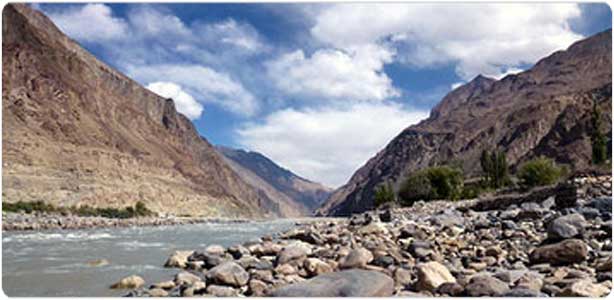The river freezes in winter, thus forming an easy access between the Khaplu and the Nubra valleys. In summer, as the snowmelts in the uplands, the river overflows its banks and inundates the surrounding plain for many kilometers, at times creating a vast marsh. During this period, the Shyok River has to be crossed on rafts of inflated skin.
The Shyok Valley is the valley of the Shyok River -- the river of death. This is a "Yarkandi" (Central Asian) name, probably given by the Central Asian traders who ventured on this treacherous route for centuries and perished. The entire northern area -- the region of the Karakoram -- has names related to death. It is evident that this was a part of the ancient trade route from Yarkand (Central Asia) to Ladakh, where many died and only the hardiest survived. The entire route towards the Karakoram Pass is littered with the bones of these travellers.
Best Time to Visit
However the road to Shyok valley is open year-round, summer is the best time to visit. It’s also more comfortable when weather is perfect with green fields. Nubra festivals are celebrated in September in different villages which include folk dances and music. The best time to explore Shyok Valley is between months of July and September.
Tourist Attractions of Shyok Valley
Diskit:
The first and largest village of the Shyok Valley is Diskit which is famous for its Tibetan style Monastery. It is the oldest and largest monastery in Nubra Valley and hosts about 70 monks. Linked by wooden steps, the Monastery is built on many levels. You can also visit the long statue of Maitreya Buddhra facing the Shyok River which is 106 ft long and situated in the top of the hill.
Diskit is also famous for its 2 Day Diskit Gustor festival which is celebrated annually in October-November. This festival comprises of masked dance performances.
Hunder:
Diskit is more an administrative centre than attractive place for tourist. 7Km ahead of Diskit, lies Hunder village which is heaven of serenity. This heaven comprises of low white houses, running water channels, luminous green fields, and sand dunes created by Shyok. Hundar is Ladakh’s only place where you can find double-humped, long-chastised, wonderful Bactrian camels.
Turtuk:
One of the youngest regions in India’s history and captured during 1971 Bangladesh war, Turtuk is last visitable village in the Shyok Valley which is 79 km from Hunder. This village opened for tourists in 2010. This village remains culturally a part of Baltistan. Turtuk village has the Balti as well as Ladakhi speaking entire Muslim population.
How to Reach
Shyok Valley is reached by a road from Leh across the Khardung La. After crossing Khardung village you will reach beside the Shyok River. Shyok village can be reached by taking a road which crosses the river and heading south east. You must continue straight for 2 Km to reach Khalsar. The Shayok Valley starts from west of Khalsar towards Baltistan with its last visitable village Turtuk which is 12 km from the Line of Control.
You can take bus from Leh to Diskit and Sumur but services are not regular. It is advisable to hire a taxi from the Leh taxi stand. Rates are fixed.


